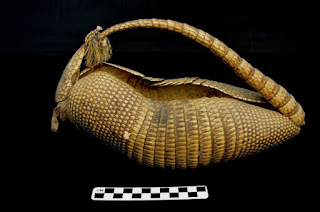The “College Town” exhibit at the Benton County Historical
Society's Corvallis Museum has items related to Oregon State University's
administration (typewriter, registrar's computer), student life and customs
(dorm photo, quilt, Lady of the Fountain) and athletics (basketball, Rose Bowl
items). The academic side of Oregon State University is represented by
Peavy's ax, symbolizing the Forestry program, and many works by the Art Department
faculty. As a former member of the Oregon State University faculty, I wish we
had more objects relating to the academic programs to display. I know, however, that it is difficult to find
relevant objects because the nature of the academic mission is inherently
internal—to foster change (learning) in the individual student. Most related
items would be written documents that are not especially visually interesting.
The sewing samples featured in the last post are a rare example of
three-dimensional student work that has survived. In addition, at the time the
historical society acquired the Horner collection, the university retained many
items for its archives.
The museum does, however, have several photographs which
illustrate the academic side of the university.
After the institution became the land grant school for the state of
Oregon, it began offering courses in agriculture on a limited basis until the
state gained control from the Methodist Episcopal Church in 1885 and the Hatch
Act (establishing agricultural experiment stations) and the Second Morrill Act
of 1890 provided additional federal funds. The first professor of agriculture
was hired in 1883 and in 1888 the state approved hiring of a chemist, a
botanist, and a horticulturalist. In this photograph from 1895, horticulture students were
learning about pruning.
In this photograph from 1903, students in a stock judging
class were learning about desirable features in sheep.
The college also had a dairy lab “equipped with all the
modern devices for testing milk and its products...”
In addition to the regular university courses, Oregon
Agricultural College (as it was called at the time) offered short 6-week
intensive classes for active farmers.
The students pictured here in the college's dairy lab in 1903 may have
been enrolled in one of these classes.
In 1899, OAC began offering a course in bacteriology which
focused on bacteriological diseases of plants and animals. These offering were gradually expanded into
the department of microbiology in the College of Agriculture. These photographs
from the 1960s show students at work in microbiology labs.
Another course of study required by the terms of the Morrill
Act for all land grant colleges is engineering. At first this was done by
incorporating engineering concepts into mathematics courses. In 1889, OAC
established the mechanical engineering program, the first on the west coast,
and hired Grant Covell as the first professor of engineering. Electrical Engineering
was added in 1897, and Civil Engineering in 1905, Chemical Engineering in 1917,
Industrial Engineering in 1943, Nuclear Engineering in 1968, and Computer
Science in 1974.
These engineering students of the 1920s were working on a
design problem that is written on the board. In this pre-computer age, they are
using slide rules to make the necessary calculations. By Martha Fraundorf, Volunteer for Benton County Historical Society, Philomath, Oregon





















